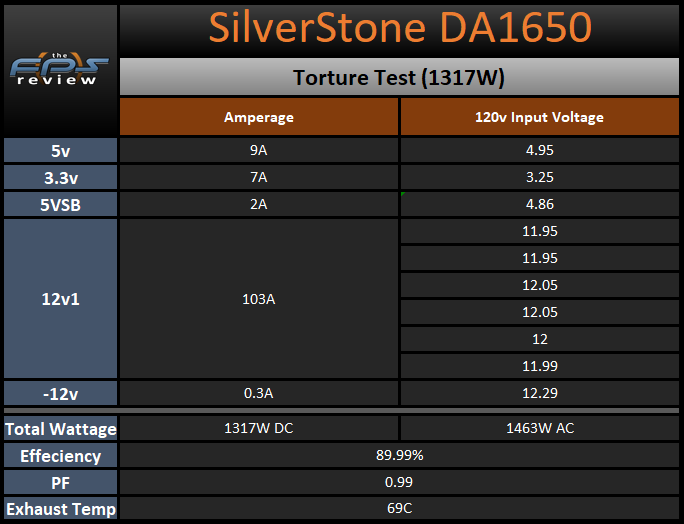Load Testing
For those of you that are curious as to some of the reasoning and equipment behind our PSU testing program here at TheFPSReview, we have put together an introduction for you. This program is based on what the author developed at [H]ardOCP and utilizes the equipment bequeathed to the author by Kyle Bennett. The testing we are conducting today is exactly as described in that document and start with our 120v, 100v, Torture, and 80 Plus Tests.
120v and 100v Load Testing Results

Test #1 is equal to approximately 25% of the rated capacity of the SilverStone DA1650 at 45c. This makes Test #1 equal to 412W by loading the 12v rail to 32a, the 5v rail to 2a, the 3.3v rail to 1a, the +5vsb to 2a, and the -12v to 0.3a. The results of Test #1 show the main positive DC output rails starting at, or above, nominal. The efficiency for this unit is starting off in excellent shape at a value of 94.04% at 120v AC input and 91.23% at 100v AC input. We see the exhaust temperature is 48C at 120v AC input and 50C at 100V AC input.
Test #2 is equal to approximately 50% of the rated capacity of the SilverStone DA1650 at 45c. This makes Test #2 equal to 829W by loading the 12v rail to 65a, the 5v rail to 5a, the 3.3v rail to 3a, the +5vsb to 2a, and the -12v to 0.3a. Test #2 sees drops in the DC output voltages relative to what we saw with Test #1. The largest changes are up to a 0.04v decrease on the 12v rail followed by a 0.03v drop on the 3.3v rail and a 0.02v drop on the 5v rail. The efficiency has moved down to 92.15% at 120v AC input and 90.34% at 100v AC input. We see an exhaust temperature of 52C at 120v AC input and 55C at 100V AC input.
Test #3 is equal to approximately 75% of the rated capacity of SilverStone DA1650 at 45c. This makes Test #3 equal to 1231W by loading the 12v rail to 97a, the 5v rail to 8a, the 3.3v rail to 4a, the +5vsb to 2a, and the -12v to 0.3a. Test #3 sees the 5v and 3.3v rails have dropped by 0.03v and 0.02v respectively. The 12v rail has mixed results as it drops by up to 0.03v and increases by up to 0.02v depending on which connector you look at. The efficiency in Test #3 moves down to 89.89% at 120v AC input and 88.47% at 100v AC input. We see an exhaust temperature of 55C at 120v AC input and 59C at 100V AC input.
Test #4 is equal to approximately 100% of the rated capacity of the SilverStone DA1650 at 45c. This makes Test #4 equal to 1644W by loading the 12v rail to 130a, the 5v rail to 11a, the 3.3v rail to 7a, the +5vsb to 2a, and the -12v to 0.3a. In the final regular test, we see the 12v rail move down by up to 0.07v. The minor rails, however, see small decreases of 0.03v (3.3v) or 0.02v (5v). The efficiency has dropped as we see it come in at 89.05% at 120v AC input and 87.03% at 100v AC input. We see an exhaust temperature of 61C at 120v AC input and 66C at 100V AC input.
Torture Test

The Torture Test is equal to approximately 80% of the rated capacity of the SilverStone DA1650 at 45C. This makes the Torture Test equal to 1317W by loading the 12v rail to 103a, the 5v rail to 9a, the 3.3v rail to 7a, the +5vsb to 2a, and the -12v to 0.3a. At the end of the Torture Test, the DA1650 is still doing well. The DC output voltages are generally in line with what we have been seeing in the 120v load tests. The efficiency is excellent as we see a value of 89.99% and the exhaust temperature is 69C.
Load Testing Summary
The SilverStone DA1650 did a very good job in our initial load testing. When we look at the voltage regulation, we see that the DA1650 had peak changes of 0.14v on the 12v rail, 0.07v on the 5v rail, and 0.08v on the 3.3v rail. These absolute values are easily in the specification. On top of that, given the huge load range, we put on this unit, they are better than what we have seen from a number of smaller units in a relative sense. We do not have any similar units to compare this one to. However, any unit would be hard-pressed to do as well as this unit did over the 1650W range we tested.
When we look at the efficiency values posted today, we see that the DA1650 ranged from 89.05% to 94.04% efficient at 120v AC input and 87.03% to 91.18% efficient at 100v AC input. As this unit was not posted to the 80 Plus certification test database at the time of testing, we do not have the 80 Plus numbers for it. However, given what we have seen here today it seems likely that this unit would have no problem making its claimed 80 Plus values. On a related note, it is both fortunate and unfortunate that we saw the efficiency curve that we did. Fortunate in that this unit was most efficient at the power output levels the vast majority of users would use it at. Unfortunate in that it was at its least efficient at full load which means it was putting off way more heat than if it had higher efficiency here. Also, I was sitting in the room slowly baking to death with it.
Lastly, the exhaust temperature peaked at 61C at 120v AC input, 66C at 100v AC input, and 69C during the Torture Test. With very good starting results in today’s testing, let’s move on to the Transient Load Tests.
